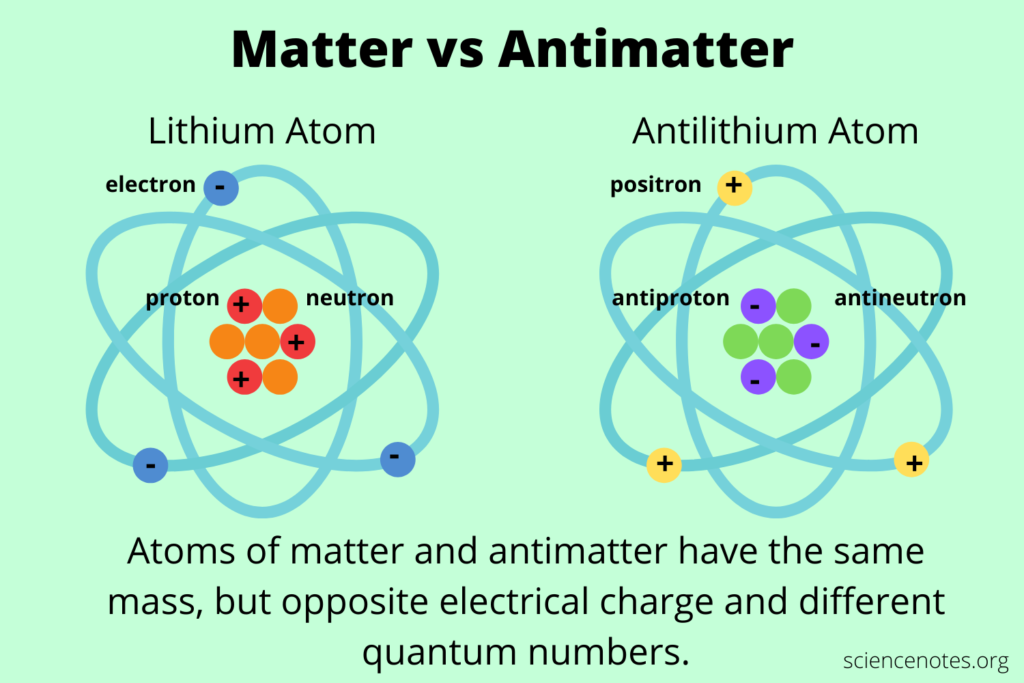
I learned this today. Antimatter is matter made up of antiparticles. An antiparticle and a particle have the same mass but opposite electrical charges.
A proton, for example, contains three quarks (2 up and 1 down), has a positive charge, and weighs 0.00000000000167262192 picograms. (A picogram is 100 billionth of a gram.) An antiproton contains three antiquarks, has a negative charge, and weighs the same. When they meet, they annihilate each other releasing energy and a light photon. The particles and antiparticles are symmetrically paired. That means, for every particle, there is an antiparticle.
Every particle has an anti-version, except for the force-transmitting particles. There is no anti-photon or anti-Higgs boson.
Antimatter was predicted by the physicist Paul Dirac. He was trying to combine the ideas of relativity and quantum mechanics. He wanted to combine Einstein’s E=mc2 with Schrodinger’s equation for quantum mechanics. He couldn’t get it to work until he had a brain wave. Everything would work perfectly if he added negative energy into the equation. It is the same as the problem x2=4. There are two possible answers. x=2 and x=-2. A positive answer and a negative answer. Both of them give 4. Using negative energy gave Dirac a way to make his equation work. Other scientists didn’t believe him at first, but a few years later, observations of cosmic rays in the upper atmosphere showed the first antimatter particles. Dirac won the Nobel Prize for his theory in 1933. His theory is called the Dirac equation and the study of quantum field theory began.
One of the problems with antimatter is that there doesn’t seem to be enough of it. Physics predicts that matter and antimatter must be made in equal quantities. All of the matter and antimatter must have been created in the Big Bang and in equal amounts. So, where is all of the antimatter? There should be equal amounts of matter and antimatter, but the universe appears to be mainly made of matter.
When matter and antimatter meet, they annihilate each other, leaving only energy. If matter and antimatter were created in equal amounts then, in theory, there should be nothing left in the universe but energy. All of the matter and antimatter would have annihilated itself. However, we can see that is obviously not the case because there is matter in the universe. So, where did all of the antimatter go?
One theory is that they weren’t created in equal amounts. Perhaps there were one billion and one matter particles to every billion antimatter particles. This could account for the left-over matter.
Another theory is that all of the antimatter is on the other side of the universe, too far away for us to see. That would have a nice symmetry to it: matter on this side of the universe and antimatter on the other side.
There are other theories, but no one knows the reason. It is a fascinating question. Physicists are trying to see if antimatter obeys the rules of physics. They are trying to find out if gravity affects antimatter. If it doesn’t, it may mean a revision of our laws of physics, gravity, and relativity.
Antimatter can be produced here on Earth. Collisions in CERN’s Large Hadron Collider can produce antimatter. They have managed to make antihydrogen and antihelium. However, not only is it incredibly difficult and expensive to make, but it is also almost impossible to store. Because matter and antimatter annihilate each other the instant they collide, you cannot keep antimatter in a container made of matter. It has to be kept in something called a penning trap, which uses a strong magnetic field to hold the antiparticles.
If antimatter was cheaper and easier to produce, it could be an incredible fuel for space travel. When a particle and an antiparticle collide, they produce energy. With enough collisions happening every second, you could power a rocket. An antimatter powered spaceship would have 10 million times the power of a conventional fuel spaceship. A milligram of antimatter could send a rocket to Mars. And the extra power would produce much faster speeds. It is theorized that a probe could be sent at 10% the speed of light towards Proxima Centauri, the closest star to us. It is 4.24 light-years away, so the probe would arrive there in about 42 years. It would then have enough energy to observe that solar system for a further fifty years.
It would take CERN about 1000 years to produce a milligram of antimatter with today’s technology, so this will not be happening in the near future. That doesn’t mean that it is impossible, though.
So, antimatter is the negative energy that pairs with the positive matter in our universe. When antimatter and matter meet, they annihilate each other, leaving energy. And that is what I learned today.
Image https://sciencenotes.org/wp-content/uploads/2020/08/Matter-vs-Antimatter.png
Sources:
https://phys.org/news/2016-01-antimatter.html
https://phys.org/news/2016-01-antimatter.html
https://www.livescience.com/32387-what-is-antimatter.html
https://www.space.com/where-did-all-the-antimatter-go.html
https://www.britannica.com/story/what-is-antimatter
https://theconversation.com/explainer-what-is-antimatter-53414
https://home.cern/science/physics/antimatter
https://www.newscientist.com/definition/antimatter/
https://simple.wikipedia.org/wiki/Antimatter
https://home.cern/science/physics/matter-antimatter-asymmetry-problem
https://en.wikipedia.org/wiki/Penning_trap
https://www.seeker.com/is-antimatter-a-viable-starship-fuel-1765998670.html
